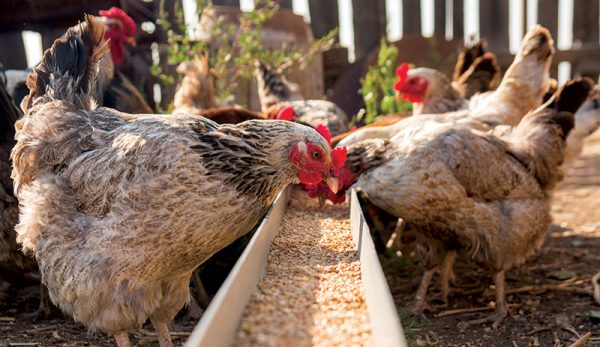How to feed chicken broilers and layers: Feed is the greatest expense in commercial poultry production therefore it is important to buy it from a reputable miller.
Variations in nutrient composition and quality of feed ingredients results in variations in feed composition and texture.
These are due to variations in raw feed ingredients from season to season and even shipment to shipment. Avoid mixing feed from several millers, adding other protein sources (fish meal etc) and mineral salts (DCP) as this changes the balance in the feedthereby affecting performance. Excess of these products also negatively affects the final product eg fishy tinge in eggs / meat due to more than 5 per cent fish meal in feed.
Broiler feeds are available in different textures as mash, crumbs or pellets. It is important to note that the difference is in the texture and not in nutrient composition which is the same.
However, birds perform better with crumbs and pellets compared to mash.
Feeding equipment
Equipment provided should be easily accessible without feed wastage through spillage and contamination.
Provide adequate feeder space as recommended below for proper growth of the birds.
Age in days
Feeder type
Recommended feeder space
Day 1-10
Chick tray
50 chicks per tray
Day 10- 21
Chick feeder
50 chicks per feeder
Day 21- slaughter/ end of production
Tube feeder
Trough feeder
30-50 birds per feeder
5 cm per bird (minimum)
Important consideration:
Allow complete feeding for birds to access all nutrients and ensure they get fresh feed. Avoid topping up, let the birds clear all feed including fine particles rich in amino acids.
Raise the feeders to the level of the birds back when standing to avoid spillage and contamination.
Ensure even distribution of feeders to cover the whole house to allow proper feeding space and avoid overcrowding in some parts of the house.
Do not store feed for more than three months to avoid deterioration of quality.
Water
No nutrient is more important to the overall health of the flock than water. Restricting access to an unlimited supply of clean, cool water will cause detrimental effects faster in your flock than restricting any other nutrient in your flocks’ diet.
A bird will consume about twice as much water as feed at normal temperatures. However, when outside temperatures increase birds can double, triple or even quadruple their water intake.
Birds consume more water when it is cool. Warm water is often rejected even if it is clean. Birds also hate water with an odd taste.
Odd tastes are most often associated with dirt, litter material, medications, additives or salty water.
If chicks are feeding and drinking properly, the crop fills with a mixture of feed and water. Gentle handling within the first 24 hours can indicate the chicks’ progress.
Check a sample of birds two hours after arrival to ensure all chicks have found feed and water. Gently sample the crop of 30-40 chicks from 3 or 4 different places in the brooder.
Chick crop fill assessment:
Age in days
Type
Recommended water space
Day 1-21
Chick drinkers
80 chicks per drinker
Day 21- end of production or slaughter
Adult manual drinker
Automatic drinker
Nipple drinker
Trough
50 birds per drinker
80-100 birds per drinker
8-10 birds per drinker
2.0 cm per bird
Distribute drinkers evenly throughout the whole house, alternating them with the feeders so that they are accessible to all birds. No bird should walk more than 1.5 m to get either feed or water. Wash drinkers daily. Ensure the drinkers are filled with fresh water daily. Ensure the birds always have access to wholesome drinking water and never allow the drinkers to go dry.
In hot periods, provide the flock with cool water as this will improve productivity.
It is therefore extremely important to protect the water tanks from direct sunlight or ensure they have a reflective surface. Always adjust the drinkers’ levels as the birds grow to ensure that the equipment is always slightly above the level of the eye.
This minimises spillage and contamination. Use reliable water sanitiser (like chlorine) to control diseases.
[The writer is the Head Vet at Kenchic: [email protected], [email protected]]








